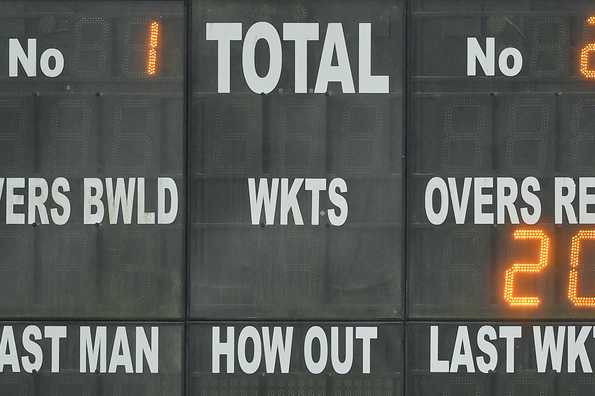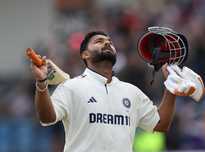The International Cricket Council (ICC) has announced alterations to the Playing Conditions for Twenty20 Internationals, primarily affecting the calculation of PowerPlay overs. This adjustment ensures greater accuracy in matches with reduced innings.

Previously, the first six overs constituted the PowerPlay, roughly 30% of a standard 20-over innings. However, when innings are shortened, rounding the PowerPlay to the nearest over could create imbalances.
Now, the PowerPlay length will be calculated to the nearest ball, providing a more precise proportional distribution.
In scenarios where the batting team's overs are reduced, the PowerPlay overs will be adjusted according to the following table. This rule applies to both the first and second innings.
| Match reduced (overs) | Powerplay overs |
|---|---|
| 5 | 1.3 |
| 6 | 1.5 |
| 7 | 2.1 |
| 8 | 2.2 |
| 9 | 2.4 |
| 10 | 3 |
| 11 | 3.2 |
| 12 | 3.4 |
| 13 | 3.5 |
| 14 | 4.1 |
| 15 | 4.3 |
| 16 | 4.5 |
| 17 | 5.1 |
| 18 | 5.2 |
| 19 | 5.4 |
For example, an 8-over innings will now have a PowerPlay lasting 2.2 overs, and a 9-over innings will have 2.4 overs. This methodology maintains the intended 30% proportion.
The ICC stated that this system has been successfully implemented in the T20 Blast in England for several years, without causing issues for players or officials. Umpires will signal the end of the PowerPlay mid-over, allowing additional fielders to move outside the inner circle.
The ICC has mandated that teams identify and name potential concussion replacements before each Men's T20I match. This levels the playing field by preventing home teams from having an unfair advantage due to a larger available player pool. Teams are required to nominate the following replacements:
Associate Member teams facing difficulties in identifying five specific concussion replacement players will have special considerations. Teams can nominate a batter as a replacement wicketkeeper. However, the match referee retains the discretion to decide whether the nominated batter must keep wicket or allow another player from the starting XI to do so. The primary objective is a like-for-like replacement, preventing teams from gaining an unfair advantage.
Players can be nominated for multiple categories. For instance, an all-rounder nominated as a batter replacement might be restricted from bowling by the referee. Concussion replacements are not restricted to the playing squad, and teams can nominate any eligible player.
The overarching principle remains a like-for-like replacement, with the referee making decisions based on the specific circumstances.
Examples:
Under exceptional circumstances, the match referee may consider a replacement player not initially nominated.
The ICC has addressed the use of saliva on the ball. If saliva or any other substance is used to alter the ball's condition, the ball must be replaced. However, to prevent teams from deliberately applying saliva to force a ball change, this new clause allows for discretion in ball replacement.
These changes are currently applicable only to Men's playing conditions, with updates for Women's playing conditions expected in October. The new playing conditions will take effect on July 10, 2025.
Newer articles
Older articles
 Indian Astronaut Joins ISS: Shukla's Mission Ushers in New Era for India's Space Program
Indian Astronaut Joins ISS: Shukla's Mission Ushers in New Era for India's Space Program
 Ashada Gupt Navratri 2025: Unveiling Dates, Sacred Rituals & Hidden Significance
Ashada Gupt Navratri 2025: Unveiling Dates, Sacred Rituals & Hidden Significance
 Rishabh Pant's Unconventional Batting Redefining Cricket, Says Greg Chappell
Rishabh Pant's Unconventional Batting Redefining Cricket, Says Greg Chappell
 Moto G54 Price Slashed in India: Check Out the New, Lower Cost
Moto G54 Price Slashed in India: Check Out the New, Lower Cost
 JPG to PDF: A Graphic Designer's Guide to File Conversion and Quality Preservation
JPG to PDF: A Graphic Designer's Guide to File Conversion and Quality Preservation
 'The Traitors' Star Apoorva Mukhija Accuses Sudhanshu Pandey of Misogyny and Verbal Abuse After On-Screen Drama
'The Traitors' Star Apoorva Mukhija Accuses Sudhanshu Pandey of Misogyny and Verbal Abuse After On-Screen Drama
 Van der Dussen to Captain South Africa in T20I Tri-Series Against New Zealand and Zimbabwe
Van der Dussen to Captain South Africa in T20I Tri-Series Against New Zealand and Zimbabwe
 20 Minutes to a Healthier Brain and Heart: Neurologist's Simple Strategies to Combat Cholesterol, Blood Pressure, and Dementia Risk
20 Minutes to a Healthier Brain and Heart: Neurologist's Simple Strategies to Combat Cholesterol, Blood Pressure, and Dementia Risk
 England's Audacious Batters Claim They Could Have Chased Down 450 in First Test Win Over India
England's Audacious Batters Claim They Could Have Chased Down 450 in First Test Win Over India
 Popular Finance YouTuber "financewithsharan" Hacked: Security Measures to Protect Your Account
Popular Finance YouTuber "financewithsharan" Hacked: Security Measures to Protect Your Account